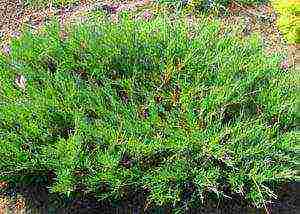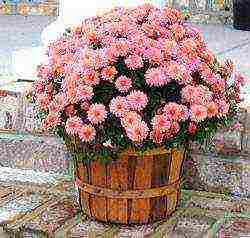Content
- 0.1 How many years have they grown
- 0.2 What year does sage bloom
- 0.3 How sage hibernates
- 0.4 Salvia officinalis (Sālvia officinālis)
- 0.5 Clary sage (Salvia sclarea)
- 0.6 Sage vegetable or common (Salvia plebeia)
- 0.7 Decorative views
- 0.8 Watering
- 0.9 Fertilizers
- 0.10 Weeding
- 1 Types and varieties
- 2 Medicinal properties and contraindications
- 3 How does sage breed?
- 4 How to plant sage?
- 5 Growing features
- 6 Pests and diseases
author Samoilova O., photo by the author
Sage, or Salvia (Salvia) - a genus of perennial herbaceous plants and shrubs of the family of lamines. Representatives of this genus are distributed throughout the world: in Europe, Asia, Africa, America. There are about 900 species and subspecies of sage. Some beautiful and healing species of this plant (oak sage, silver sage, medicinal sage, common sage, meadow sage, brilliant sage, clary sage, etc.) are grown by gardeners as ornamental and medicinal plants.
That's what I want to write about clary sage, tk. it grows in my garden.
Features of clary sage
Clary sage (Salvia sclarea) I have been growing on the site for eight years. Clary sage is native to the Mediterranean; in nature, it grows in the Crimea, the Caucasus and Central Asia.
Clary sage is a perennial plant, a semi-shrub (as they say in most sources), so initially I was also in this mood for my sage. But as I grew it, I noticed that my clary sage did not bloom in the first year of planting or sowing; it only forms a basal rosette of large, pubescent, slightly "corrugated" (wrinkled) leaves. But the next year, the young plant blooms.
In autumn, the faded plants give seeds (which even in Siberia have time to ripen), then die and the cycle repeats. This is how biennials behave. This means that clary sage is not only a perennial plant. And indeed it is. The fact is that biennials (most of them), annuals and few perennials can be found in the offspring of the same plant (note, of the same plant!).
The farther north the region where this plant is grown, the better, of course, to grow one-year or two-year-old clary sage, because perennial sage can freeze out. But, if in winter there were no critical subzero temperatures, then the biennial sage does not die, but it can continue to grow and bloom for another couple of seasons.
I'll tell you about how clary sage appeared in my garden.
I wanted to breed this plant, because I read a lot about its medicinal properties and extraordinary aroma, and for me this plant was a mystery ...
Indeed, clary sage is an unusual and mysterious plant. At least the fact that during flowering a crazy aroma comes from it. Just a fabulous smell, in which, as it seems to me, all the best and mysterious aromas of the world are mixed!
And so, when I met a clary sage sapling at my grandmother's bazaar, I immediately bought it without hesitation. It was a small plant, with two small, as if corrugated leaves. Granny assured that it was exactly clary sage.
I took a sage seedling home in a closed package; and when she opened it at home, she smelled a pungent cat scent. I was very surprised and thought that it was grandmother's cats who tried ...
But when the bowl with the plant stood open, the cat smell disappeared. It was then that I realized that it was the smell of musk.
Growing clary sage
The clary sage planted in the garden has grown during the summer. Then he overwintered safely, and bloomed the next summer.
I have noticed that depending on the season, my clary sage can grow from 60-70 cm to a significant height of 1.2-1.5 m.
The branched stem root of this large plant penetrates to a depth of 2 m. Therefore, sage does not tolerate transplantation, it is sick for a long time and may die. It is better to transplant sage in the first year of life and at the very beginning of growth, i.e. at the beginning of summer.
Clary sage is considered a relatively thermophilic plant.But in Siberia, a two-year-old sage hibernates without shelter, and there are no losses.
Frost resistance of clary sage, like any biennial or perennial plant, depends on how well it has matured by the fall. Also, sage does not like the alternation of winter thaws with frosts.
Clary sage is undemanding to soil and drought tolerant. But in order for its flowering to be abundant, and the fragrance of the flowers to be stronger, of course, the garden soil must be fertile, and in a drought there must be sufficient watering of the plant.
Affects the sage flower aroma and the choice of a sunny location. The hotter the summer, the more essential oil accumulates in the herbs, and the stronger the aroma!
The appearance of clary sage is also influenced by the thickening of the plantings, and the weeds removed around the wrong time. All this affects the growth and flowering of the plant, and, therefore, the intensity of its aroma.
Flowering and fruiting of clary sage
In the second year, clary sage grows a powerful peduncle (up to 1.5 m high) with long spike-shaped inflorescences covered with pale pink flowers and bracts.
Clary sage blooms very beautifully. If you look at the mass of flowering plants, it is as if a delicate white-pink-lilac cloud hovered on their tops. And what a tremendous aroma is there at this time ... you can go crazy with it!
The smell of clary sage flowers is difficult to convey; its essential oil has a complex chemical composition that creates a unique healing bouquet. Fragrance connoisseurs say that clary sage flowers give off a scent reminiscent of a mixture of rose, lily of the valley, lemon and lavender scents.
Clary sage seeds ripen well in September. Self-seeding takes place, and next year its seedlings can be found in any corner of the garden where the land is cultivated.
Clary sage seedlings do not appear in early spring, but already in late May or early June, because Clary sage is a heat-loving plant. Its seeds begin to germinate at a temperature of + 8 ... + 10 degrees. But at the same time, young sage, which has a rosette of 10-12 pairs of leaves, withstands sub-zero temperatures already in the first year of life. Here is such a mysterious plant!
Smart books write that clary sage has something else that many, many plants do not have. These are inhibitors - substances that inhibit plant growth. The root system of clary sage releases essential oils into the soil, which inhibit or even prevent the development of plants planted in the place where sage grew. And even the seedlings of the same sage, which emerged here after harvesting sage bushes, cannot develop normally in this place - they grow depressed, or even die altogether. But I haven't noticed anything like this on my sage yet. Moreover, in one place the bush has been growing for me for six years. Its seeds fell nearby in the fall, and sprout in the spring; of these, I left a few plants for propagation. And now, in the sixth year, the sage bush was much more powerful (up to one and a half meters), and the flowering was more abundant than in previous years. Maybe the summer was favorable for him.
Pests and diseases of clary sage
Clary sage in the garden is affected by both harmful insects and diseases. It is damaged by spider mites, sage scoops, sage weevils and other pests. It seems to me that slugs do not disdain them, despite the essential oils secreted by the plant, because For the last couple of years I have been seeing characteristic holes on the leaves of clary sage.
This plant has a common disease with sunflowers - they are affected by white rot. It leads to partial or complete death of sage in the second year of life. Therefore, do not plant these plants next to each other, sow them away from each other.
Clary sage can be affected by powdery mildew, leaf spot. But my sage bushes have never gotten sick (and I hope they won't).
The use of clary sage in medicine
In clary sage, fragrant inflorescences are a medicinal raw material, from which essential oil is extracted. The stems and leaves of this plant contain several times less oil.
The essential oil is applied to a pillow or wrist. You can use an aroma lamp or aroma medallions - this is very convenient.
But first, you must first check the aroma of clary sage essential oil for individual tolerance. When applied to the skin, it causes burning and redness within 3-5 minutes - this is a natural reaction.
Clary sage essential oil is considered a good anti-inflammatory and healing agent, as well as relaxing, soothing, antibacterial, antiseptic, tonic, antioxidant, expectorant. It relieves inflammation in the throat, restores a hoarse voice.
Clary sage oil is used for the prevention of acute respiratory infections, in aromatherapy: for seasonal depression, chronic fatigue, nervousness, fear.
The scent of clary sage essential oil relieves headaches and migraines associated with hormonal problems.
It is believed that clary sage essential oil goes well with oils: bergamot, cardamom, lavender, grapefruit, coriander, jasmine, frankincense, juniper, sandalwood, rose, basil, geranium, pine, thyme, cedar, cypress.
Sage preparations and essential oil have a venotonic effect, they are included in the collection for hemorrhoids, varicose veins and circulatory disorders. Essential oil of clary sage is used for acne, pustular diseases, hair loss, oily skin of the face and scalp. It restores strength and growth of hair, reduces excessive sebum production (especially on the scalp).
The scent of clary sage oil can be used as a repellent because it repels mosquitoes and is an antidote to insect bites.
Clary sage is used in dentistry, in the complex treatment of psoriasis. Traditional medicine uses this plant for kidney stones, headaches.
Dry inflorescences of clary sage are added to various herbal preparations. Inflorescence inflorescence for external use is prepared at the rate of: two tablespoons of raw materials per glass of boiling water; insist before cooling. The resulting infusion is used to wipe problem skin, rubbed into the scalp for oily hair.
There are also contraindications for the use of clary sage essential oil. First of all, it is not recommended to use it during pregnancy and breastfeeding (it inhibits lactation).
Use with caution in high-grade hypertension.
You can not use it when taking iron supplements. Contraindications are also cancer, mastopathy.
Because clary sage essential oil relaxes, concentration is impaired and cannot be used while driving.
Clary sage oil is believed to enhance the effects of alcoholic beverages, so it should not be used while drinking. Remember, a headache can occur when using essential oil in large doses.
Varied Uses of Clary Sage
Clary sage oil is used in the perfumery industry - as a fragrance and odor fixer in the manufacture of perfumes, colognes, creams, pastes, shampoos, lotions.
Clary sage is used in the production of beer and wine, in the confectionery industry (as a flavoring agent for jams), in the food industry (for flavoring cheeses and tea).
In the tobacco industry, clary sage is used to flavor expensive tobacco, for which leaves and inflorescences are usually used. Collecting fragrant leaves can be started as soon as the plant blooms.
Fatty oil of clary sage seeds has high technical properties.It is used in ceramic and porcelain production, for the manufacture of top quality drying oil.
Clary sage in garden design
Clary sage is very decorative, so it is used in garden landscaping. It will look good as a large curtain against the background of the lawn.
You can plant tall clary sage in the background in mixborders, in flower beds it goes well with different plants. Since the inflorescences of sage are spike-shaped, plants with other forms of flowers and leaves will be appropriate next to it. For example, these are various ornamental grasses and irises (marsh, bearded, Siberian), geraniums, daylilies, dahlias, birch sap, etc.
This is such an amazing plant - clary sage.
All about Salvia on the site
Green pharmacy on the site
All about plants in cooking on the site
Garden world on the site
 A variety of perennial sage varieties are used in landscaping to create amazing compositions. Planting, caring for and propagating these plants is straightforward. However, there are some peculiarities of growing them outdoors.
A variety of perennial sage varieties are used in landscaping to create amazing compositions. Planting, caring for and propagating these plants is straightforward. However, there are some peculiarities of growing them outdoors.
Varieties and varieties
The Latin name of the plant "Salvia" in the Russian interpretation means "to be healthy." Photo culture is often the hallmark of pharmaceuticals. It is a perennial herb, a shrub. Stems are tetrahedral, erect, reaching a height of 1.2 m. Shoots are densely covered with wedge-shaped leaves 4 to 8 cm long and 1 to 3 cm wide. The shape of the inflorescence is a spikelet or panicle. Small bright flowers bloom in mid-July and bloom until late autumn.
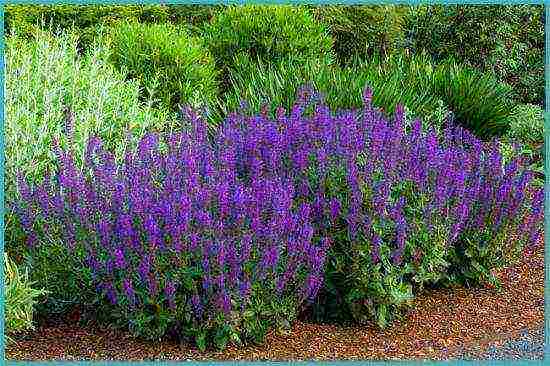
Sage is not only a beautiful but also a very useful plant.
The most common types are:
Salvia officinalis (S.officinalis) is a plant reaching a height of 20-70 cm. The leaves are elongated, narrow (0.8-1.5 cm), densely pubescent, gray-green in color, the stem is covered with whitish villi. It is widely used in cooking, medicine and cosmetology. Varieties:
- Breeze is a semi-shrub up to 60 cm high with jagged leaves and blue-blue flowers;
- Aibolit is a tall plant (up to 120 cm), distinguished by wrinkled dark green foliage with a strong edge;
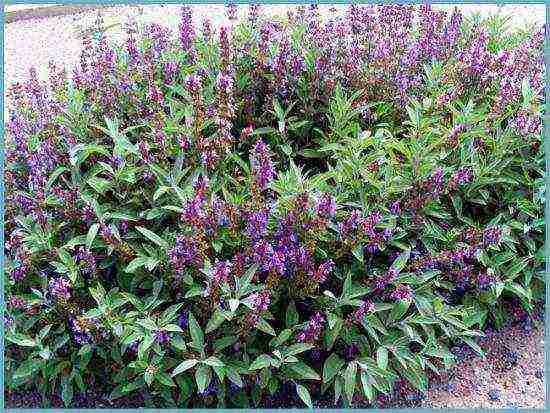
Salvia officinalis
- Nectar is a medium-sized bush, reaching 1 m in height. Leaves are light green, strongly pubescent. Spike-shaped inflorescences are strewn with purple or blue flowers;
- Semko Patriarshy is a low plant (50-70 cm) with long (up to 10 cm) leaves that densely cover the stalk stiff from below.
Forest sage (oak, wild - S. nemorosa) is a spice plant found on the edges of forests and on hillsides in the Mediterranean countries. The stem is herbaceous, the leaves are narrow, lanceolate. The flowers are collected in spike-shaped inflorescences of the violet or blue spectrum. Varieties:
- undersized - Plumosa, Blue and Pink Queen, Marcus - reach a height of 25 to 50 cm, bloom with pink, purple, blue and purple flowers;
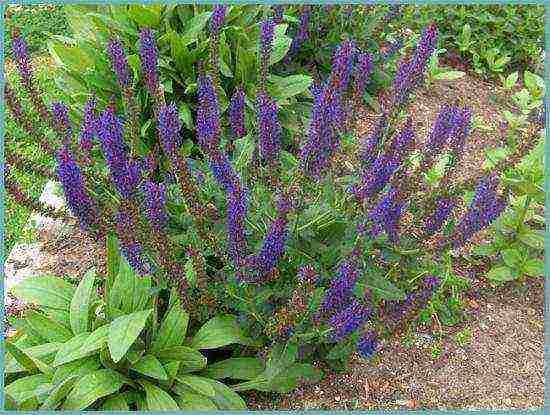
Forest sage
- tall - Adrian, Caradonna, Mainacht, Ametist - peduncles reach a height of up to 90 cm, dense spike-shaped inflorescences convey a wide range of colors - from white-pink delicate shades to deep violet-blue.
Meadow sage (S.pratensis) and Clary sage (S.glutinosa) is a species of oak sage. Sh. Sticky deserves attention because of the unusual greenish-yellow color of the leaves. Interesting photos, where lush paniculate inflorescences of a pale yellow color create a delicate background for brighter flowers.
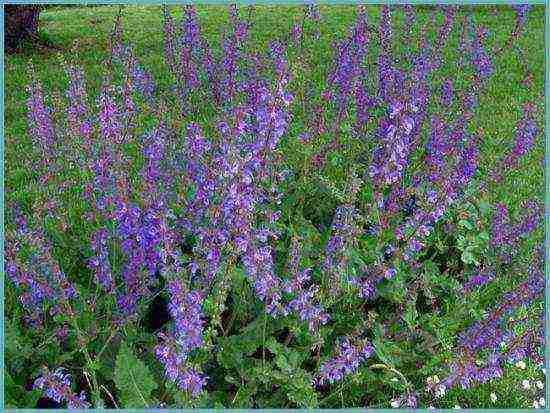
Meadow sage
Planting a plant
Different types of sage are ambiguous about equal conditions. Oak and meadow prefer sunny areas and moderate watering. These are drought-resistant plants for which waterlogging is dangerous. Clary sage naturally lives on the edges of the forest, so light shade and moist soil are of the highest priority for it.
Despite the differences, there are general requirements:
- salvias grow more readily on light sandy loam soils;
- prefer humus-rich soil of normal acidity (pH = 6.5);
- require shelter for the winter;
- need spring pruning.
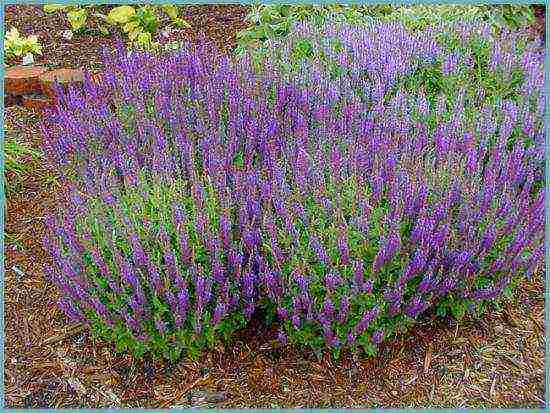
Sage is very thermophilic, so it needs to be covered well for the winter.
Because sage is a thermophilic plant, some perennial species are grown as one or two years in regions with harsh winters.
Important! Sage is a cross-pollinated plant, therefore, to preserve species characteristics, different varieties are planted at some distance.
Plant care
The plant is quite unpretentious - care consists in removing weeds and loosening the soil. For the winter, even the most frost-resistant species are covered with fallen leaves. In early spring, old shoots are cut, leaving about 10 cm from the root, the rosette is mulched with cut grass or peat. Watered very carefully, avoiding stagnation of water. Often in the photo you can see such a landscape design technique as gravel mulching. This method is also acceptable for sage.
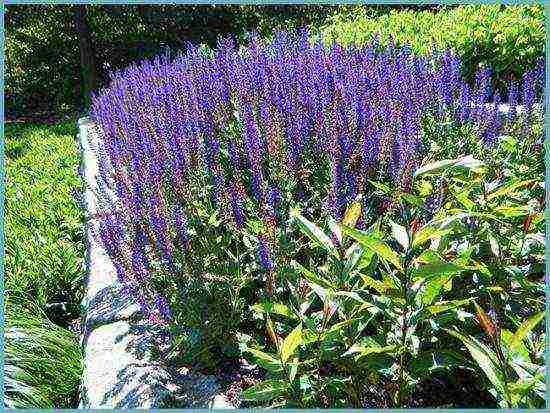
Mulch the soil, this will help the crop retain the necessary moisture
Fertilization and feeding
The correct development of sage is ensured by timely feeding:
- at the beginning of shoot formation, the plant perfectly accepts nitrogen fertilizers (for example, slurry in a ratio of 1: 10);
- during the period of bud formation - complex mineral fertilizers containing potassium and phosphorus (at the rate of 15-20 g per m2).
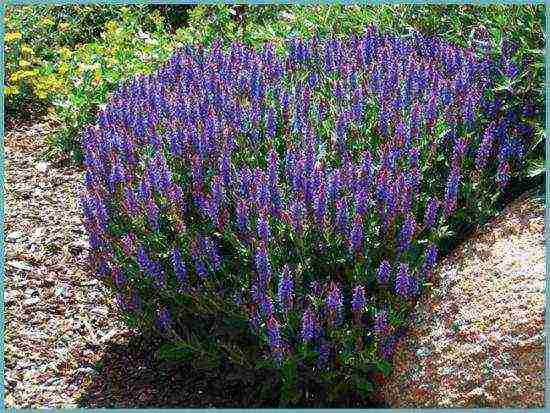
To feed sage you need mineral fertilizers
Fertilize the soil before planting a plant by introducing organic fertilizers (0.5-1 kg) into the wells in combination with mineral fertilizers (3-5 g).
Important! When planting sage, only rotted manure is used.
Reproduction of sage
Propagated in three ways:
- vegetatively - lignified cuttings;
- seeds and seedlings;
- dividing the bush or layering.
To obtain seedlings, seeds are sown in prepared containers in February-March. The first shoots appear in 1.5-2 weeks, and in the third week after planting, the seedlings dive into peat pots. In warm areas, already in April, seeds can be planted directly into open ground or used for winter planting. For spring sowing, the seeds are pre-soaked in a growth stimulator; in the fall, only dry seeds are embedded in the soil. The distance between the grooves is 15-20 cm, the depth is 4 cm.
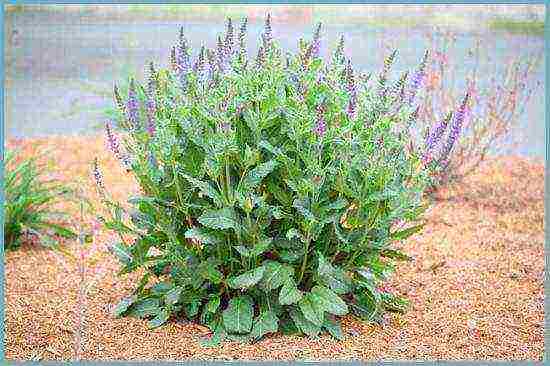
The easiest way to propagate sage is by cuttings.
Cuttings are carried out at any time. For this, semi-lignified shoots are cut into 15 cm long pieces and rooted in a vessel with water. New roots appear within 2 weeks.
The pivotal root system of sage has the ability to form well-developed adventitious processes, so in late summer or early autumn, the bush can be planted painlessly.
Diseases and pests of sage
Since sage belongs to the group of herbal medicinal plants, in itself it is an excellent insecticide, resistant to diseases and pests. When over-watering, there is a danger of mildew (mold) damage, so the soil around the plant should be slightly moist, but not waterlogged. Spraying with sulfur solution is a good remedy for mold. Pests rarely disturb the plant, but with thickened plantings, slugs, spider mites and thrips may appear.

Of the pests, sage is most often overcome by slugs.
Diseased plants are treated with tinctures of garlic, onion peels in combination with a solution of laundry soap.
Traditional methods of pest control
- Finely chop two heads of garlic, pour a liter of water and leave for 5-7 days in a dark place. Dilute in a 1: 1 ratio with water, add 3-5 g of laundry soap, and spray the plants.
- For 100 g of onion husks steamed in 5 liters of water, take 10 g of soap, spray immediately after cooling.
Shrub sage: combination with other plants
Light airy spikelets of sage go well with large heads of noble flowers.The wide blue-violet palette creates a gorgeous backdrop for warm shades of reds, yellows and oranges.

Sage in a common flower bed
Examples:
- the combination of sage with chrysanthemums, roses, lilies is used in the design of classic gardens;
- bulbous - irises, daylilies, tulips, hyacinths in a company with sage will add charm to the alpine hills;
- for landscape design in a rustic style, varieties of oak sage in combination with cereals and herbs are irreplaceable.
Shrub sage in landscape design
One- or two-year-old hybrid varieties of sage, such as brilliant salvia or clary sage, are most often used in garden design. Nevertheless, perennials are often used to create mixborders, flower beds, flower beds.
A common use of perennial sage is to create a spice garden or aroma garden. A classic example of Salvia's neighbors on such an island:
- peppermint and apple;
- creeping thyme (thyme) and lemon;
- oregano and hyssop;
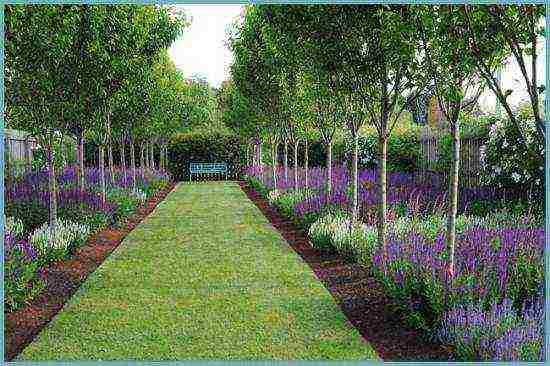
Sage in landscape design
- basil and rosemary;
- parsley and cucumber herb;
- chives and leeks.
Practical use of sage has earned him the fame of a garden healer. Essential oils and a varied composition of trace elements help in the treatment of lung diseases. In aromatherapy, sage is considered one of the most powerful sedatives. The plant is widely used in cooking as a spice. Growing perennial species in the garden guarantees health and good mood.
Sage cultivation and its benefits: video
Blooming sage: photo


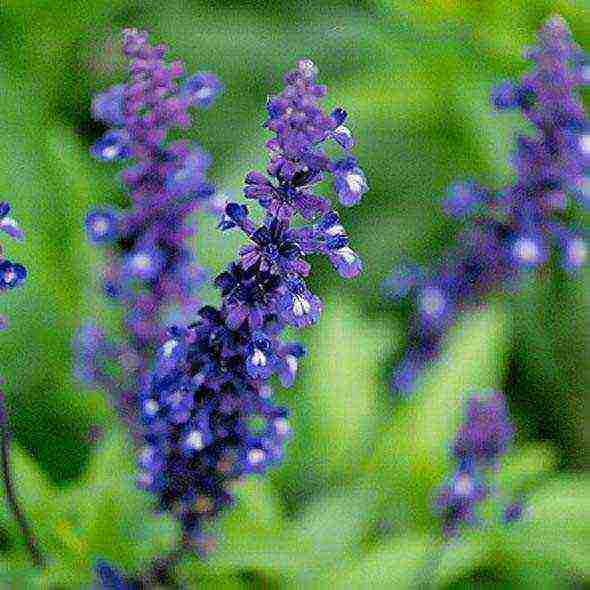
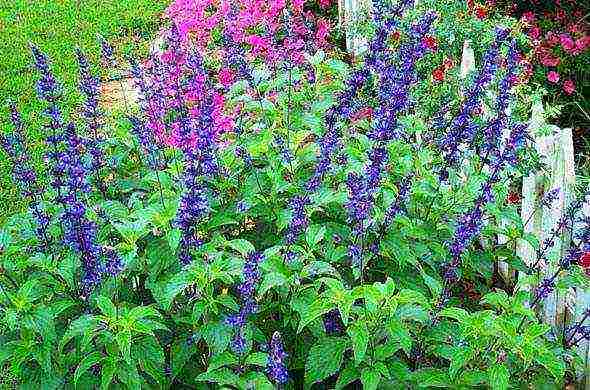
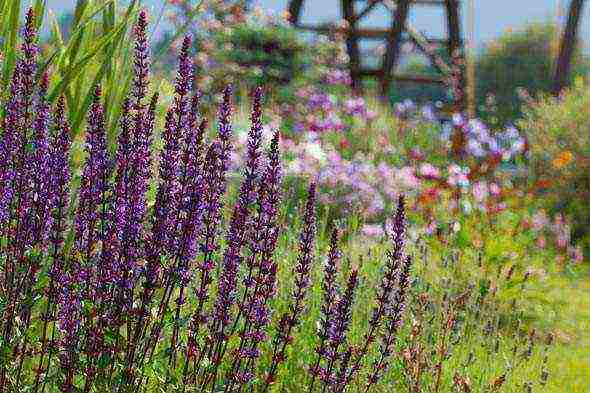
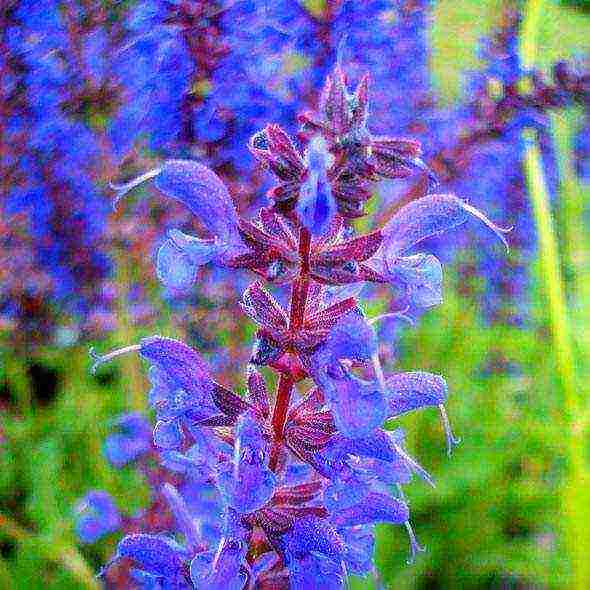
In warm Europe, sage is grown everywhere. Tea is brewed with it, it is treated, wines are infused, added to meat and fish dishes. Sage is popular, but temperate gardeners rarely plant it. Perhaps because they do not know how to care for him.
Features of growing sage
Sage or salvia is a perennial herbaceous bush, cultivated in summer cottages, mainly as a two- and one-year-old. Taproot, penetrates the soil up to 2 m, branches strongly. Each branch ends with a large inflorescence. Stem height 50-150 cm, depending on the species. The flowers are pinkish, purple, white, blue, lavender.
Sage is a long day plant. It blooms at high light intensity. It blooms in July-August, the seeds ripen in August-September.
Sage is diverse in life forms. Biennials, annuals and perennials can be found in the same batch of seeds. The farther north the plants are grown, the more you need to rely on annuals.
How many years have they grown
The homeland of sage is the Mediterranean. In France and Italy, it is grown as a 3-5 year old crop. In temperate and cold climates, due to the more severe wintering conditions in the third year of life, the plants mostly fall out, and the garden becomes empty, so sage is cultivated for no more than 2 years.
What year does sage bloom
Annual forms bloom in the first year after sowing and die off in winter. Biennials will form a rosette of leaves in the first year, and bloom and produce seeds in the second year. Perennials bloom in the first and subsequent years of the growing season.
Sage, sown before winter, will bear fruit in the first year of life, if a moderate temperature is kept during the period of emergence-rosette of leaves. Therefore, in regions with a hot climate, sage does not bloom in the first year of life. In its homeland in the Mediterranean, sage also blooms only in the second year.
How sage hibernates
All sage species are thermophilic. If there is no thick layer of snow on the garden bed in winter, the plants may freeze. In bare places, sage freezes even in warm regions: in the Krasnodar Territory, Crimea, Moldova. To prevent this from happening, in the fall, the bushes are easily sprinkled with soil or sprinkled with dry leaves. In this form, they will winter well and will endure even severe frosts.
In spring, plants start growing when the average daily air temperature rises to 5-6 degrees.In warm winters in the southern regions, there are frequent cases of premature awakening of sage in February-March.
Sage species
Three types of sage are grown in culture:
| View | Popular varieties |
| Drug | Dobrynya, Kubanets, Purple Aroma |
| Nutmeg | Ai-Todora, Voznesensky 24, Crimean Late, Orpheus, C 785, Salute, Taigan |
| Vegetable | Aibolit, Breeze, Nectar, Patriarch Semko, Healer |
Salvia officinalis (Sālvia officinālis)
The plant is unpretentious. It feels good on different soils, is drought-resistant, does not require frequent fertilizing and complex treatments from pests. Blooms in late June. At this time, its unique spicy-pungent smell is spread throughout the site, to which bees flock from all sides.
Clary sage (Salvia sclarea)
The plant is not demanding on the soil, but it loves warmth. Seeds germinate at a temperature of 8-12 degrees. Shoots appear faster at 23-28 degrees. Mature bushes can withstand frosts down to -30. In order for the plant to develop well, an average daily temperature of 20 degrees is needed. Essential oil, valuable for perfumery, is made from clary sage.
Sage vegetable or common (Salvia plebeia)
Plant for salad purposes. It is a perennial upright shrub up to 50 cm tall. The flowers are blue-violet, fragrant. Blooms in June and July. In the second year of the growing season, the weight of the plant reaches 300 grams.
Vegetable sage grows in one place for 5 years. Its leaves are used fresh and dried as a seasoning in the preparation of wine, cheese, sausages, canned food, and hot dishes.
Vegetable sage can be grown at home in pots, outdoors, on balconies and in flowerpots. Seedlings easily tolerate frosts down to -6 degrees, so the seeds can be safely sown before winter.
Decorative views
The most famous ornamental sage is the brilliant sage or Salvia splendens. It differs from other species in the solemn bright red color of the petals. The flower is used in urban landscaping, planting seedlings in squares, parks, squares, near public institutions.
For decorative purposes, oak or Moldavian sage (Salvia nemorosa), a perennial with a stem height of up to 90 cm, is grown in garden plots. It blooms with dark purple flowers in June-August. This is a summer honey plant.
Oak sage is planted in partial shade, on loose, nutritious soils. In central Russia, it winters well, but in areas not covered with snow, it can be damaged by frost.
Sage looks beautiful on the site next to roses. When covering rose bushes in autumn, do not forget to cover the salvia immediately.
Another decorative salvia - mealy sage (Salvia farinacea) - comes from America. It is a perennial plant, up to 50 cm high, with blue or purple flowers. There are white and blue varieties. In the middle lane, powdery sage is grown only in a cold greenhouse.
Preparing for landing
Sage is cultivated by direct sowing and seedling. Ornamental garden species can be propagated by dividing the bush.
In the fall, the bed is dug to the depth of the bayonet, the weeds are removed. In the spring, they are loosened to a depth of 5-6 cm.
The seeds germinate in moist soil. With a lack of moisture, they will be covered with a film and fall into dormancy - this is the legacy of the wild ancestors of sage, which grew in the arid steppe zone and emerged only during the rainy season. Sage is not picky about its predecessors, but it cannot be planted in one place for many years.
The culture is planted on any soil, except for heavy and swampy. In fertile areas, the plant grows faster and blooms more abundantly. Ph is better neutral or slightly acidic.
Landings must be protected from cold winds. Plants don't like shading. Sage can even be grown on slopes, as long as they are not facing north.
Planting sage
Seeds are sown as soon as the soil dries out and warms up. Sowing of freshly harvested seeds before winter is possible. To improve germination in August-September, they are warmed up for 2 weeks in the sun.With any sowing - winter or spring - by the end of the first season, salvia grows into large bushes, from which you can collect leaves. This feature allows sage to be grown as an annual crop.
Seeds are planted 4 cm. On clay soils they sow smaller - by 2-3 cm. Leave 30-40 cm in a row, 45-80 cm between rows.
Possible layouts in the open field:
- 70 to 70;
- 70 by 30;
- 50 + 50 to 90.
The greatest yield is obtained when planting according to a 70 to 70 scheme.
Sage care
Sage is harvested in a flowering state. The leaves can be used fresh or dried in a draft. The branches are cut, leaving 10 centimeter segments at the root.
Watering
The culture is drought tolerant and tolerates lack of water. It may not be watered at all, but in drought the leaves become tough. It is only important that in the period from the beginning of germination to the appearance of stems in the upper layer of the soil there is enough moisture.
When grown without watering, the yield will be lower, but the aroma in the plants is more pronounced due to the increased content of essential oils.
The culture does not tolerate the close occurrence of groundwater and waterlogging. If it is decided to water the garden bed, it is important not to do it often and abundantly - mushroom diseases flourish on sage in dampness.
Fertilizers
Plants are most in need of nitrogen and phosphorus. Before sowing, they are applied per sq. m:
- nitrogen fertilizers 5-7 g;
- phosphoric 20 gr.
In the first year of plant life, one top dressing is carried out in the phase of formation of two pairs of true leaves. In the second year, they are fed in the spring, at the beginning of the regrowth of the leaves. For both dressings, use a tablespoon of ammonium nitrate and a tablespoon of superphosphate per 1 sq. m.
Weeding
In the first year, the plant develops slowly. The garden has to be weeded often so that weeds do not overwhelm it. In the second year, weeding is carried out as needed. Sage roots release substances into the soil that inhibit the growth of other plants, so the garden with mature bushes does not overgrow.
It is possible to grow sage under cover. In the fall, fast-growing greens or vegetables are sown at the same time: dill, lettuce, cilantro, radish. In spring, the cover crop is harvested, and sage forms strong and developed rosettes over the summer.
Reproduction
If you plan to use sage seeds for sowing, it is best to plant several specimens side by side, as it is a cross-pollinated plant. A single bush may not set seeds.
The largest plants with a strong aroma are left on the seeds. Leaves are not collected from them.
The inflorescences are removed when 2-3 whorls turn brown. The inflorescences are cut over the top pair of leaves, then tied into bunches and suspended under a canopy "upside down" for ripening. At the bottom, you need to spread the film so that the spilling seeds collect on it.
Sage disease
Sage is amazed:
- peronosporosis;
- spider mite;
- darkling beetle larvae;
- specific pests - sage scoop and sage weevil.
In damp conditions, the plant suffers from white rot or sclerotinosis. The disease leads to the death of the plant at the beginning of the second year. In the garden, another plant, the sunflower, is often affected by white rot, so these two crops cannot be sown after each other and it is better to separate in space.
When growing sage in the open field, it is necessary to properly organize the planting of the plant and provide regular care for it. With due care, wonderful bushes will become a worthy decoration of any flower garden.

Types and varieties
Sage is a semi-shrub from the Yasnotkovy family up to 75 cm high. The stem is lignified in the root zone. On the shoots, wedge-shaped leaves up to 8 cm long and 1-3 cm wide are densely located. The racemose inflorescences of violet-blue, white or pink color appear in the second year of life, from May to July. There are one-, two- and perennial varieties of sage.
- Medicinal sage (salvia) is the most famous member of the family.It is actively used in cooking and medicine. There are many hybrids of this species. The flowers are purple and the shades of the leaves are varied. There are specimens with reddish, lilac and silvery foliage, some with bright golden-white spots.
- Clary sage attracts with its rich taste and smell, as well as large light purple inflorescences. It is used to brew aromatic tea, used in bouquets.
- The pineapple variety is an autumn plant with a fruity taste and scarlet flowers, which is transferred to a room with a positive temperature in winter. It is used to make herbal tea.
- Oak sage (summer) is a perennial with fragrant leaves and dark purple flowers that delight from late spring to early summer. If you prune the bush at soil level in early August, it will bloom again in September. Hardy and durable plant with vigorous growth.
- Mealy sage is a dull, fast-growing green species.
- Sage Voznesensky 24 is a plant up to 2 m tall, with large heart-shaped leaves of a dark green color. There are perennial and biennial varieties. Blooms already in the year of planting. The flower has a green calyx, a violet-blue upper lip and a creamy white lower lip.
Sage species can be cross-pollinated if grown side by side. To preserve the specific features, they are planted as far as possible from each other. This is especially true for rare perennial varieties.

Medicinal properties and contraindications
Sage is widely used not only for decorating personal plots. Other beneficial qualities of the flower are known.
- Salvia is used for diseases of the stomach, lungs, liver and kidneys.
- Used for viral, gynecological and skin diseases.
- The plant has anti-inflammatory and antimicrobial properties.
- Sage essential oils help fight stress and headaches.
- It is a valuable source for the manufacture of perfumery and cosmetic products.
- A fragrant spice with a tart taste is used in cooking.
- Sage is a wonderful honey plant. The honey collected from the plantations of this plant has a pleasant aroma and golden color.
Sage should not be used for pregnant and lactating women, for breast cancer and acute inflammatory processes in the kidneys. Hypertensive patients should use salvia with caution, as it can increase blood pressure. You should not use sage for more than three months without a break: some plant substances accumulate in the body and can cause poisoning.

How does sage breed?
There are 4 main ways of plant propagation: seeds, shoots, dividing the bush and layering.
- Seeds.
This is the most popular method. In February or March, seeds are placed in the prepared nutrient substrate. Planting is watered regularly. After about a decade, the first shoots appear. Seedlings dive at three weeks of age. When the weather is warm, young plants are transferred outside, to a permanent growing area.
You can sow seeds directly into open ground by first soaking them in a growth promoter. In May, seeds are introduced into the prepared soil to a depth of 3 cm. The distance between adjacent specimens is at least 30 cm, row spacing is at least 50 cm. The first shoots appear in about 2-3 weeks. The land in the area with young growth is regularly moistened, preventing the soil from drying out.
- Shoots.
From semi-lignified shoots, shoots about 15 cm long are cut. The cuttings are placed in water so that roots appear. After two weeks, newly formed plants are planted in the ground.
- Dividing the bush and layering.
In early spring or late summer, you can plant an overgrown bush, separating the adventitious processes. Cutting is obtained by bending a branch of a growing flower to the soil. It is fixed with a wire at a distance of about 10 cm from the top.In less than a month, the cuttings will take root - and it can be transplanted by cutting it off from the mother liquor.
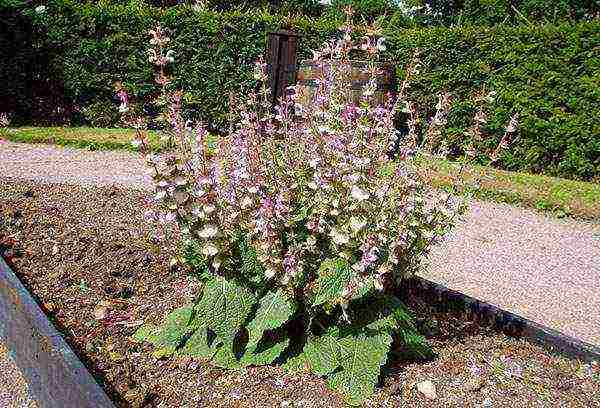
How to plant sage?
Well-lit areas in the garden or in the country are suitable for salvia. The more light and heat a plant receives, the better it develops. Light, fertile soil with normal acidity and no stagnant moisture - ideal soil for all types of sage. In clay soil, additional sand and humus are added to provide the roots with good aeration. Good precursors for sage are cabbage, legumes, potatoes, and onions.
When sage is sown in open ground in March-April, the plantings are covered with foil. If the work is carried out in May, additional shelters will not be required.
Salvia can be planted before winter. In this case, the seeds are placed in prepared soil in early October or mid-November, depending on climatic conditions and weather. The planting depth is 4 cm, the row spacing is about 50 cm, the distance between the plants is about 20 cm. The sowing time is chosen so that seedlings do not appear before the onset of cold weather. In the spring, too thick plantings with young plants are thinned out, "extra" plants can be transplanted to another place.
The distance between the bushes is indicated in the instructions on the seed bag. Sage has a powerful root system, the interval between adjacent specimens should be at least 30-40 cm.
Growing features
The main types of work on the site with sage are familiar to any summer resident.
- Regular watering.
The flower is drought-resistant, does not like waterlogging. Young plantings are often moistened, preventing the soil from drying out. Adult bushes are watered less often, taking into account weather conditions, planting density, soil composition and plant condition.
- Timely loosening.
This type of garden care is carried out after every watering or heavy rain. Take care not to damage the root system. If, during loosening on large specimens, large shoots are accidentally separated, they can be used to propagate the bush.
- Weed control.
The process is carried out after watering, while loosening the soil.
- Protection against diseases and pests.
Sage plantings are regularly inspected in order to notice the problem in time.
- Top dressing.
At the beginning of the growing season, mineral and nitrogen fertilizers are applied, and in the fall, potassium-phosphorus fertilization is carried out according to the instructions. Take about 13 g of ammonium sulfate, about 23 g of superphosphate and 9 g of potassium salt per square meter of planting.
- Pruning bushes and removing damaged parts.
Perennial varieties are shortened. Over time, the bushes "go bald" and lose their decorative appearance. Cutting is done in spring and autumn, leaving sprouts 10 cm long. After pruning, young shoots are formed on the flower, the plant renews itself and becomes attractive again.
On all varieties, diseased, damaged and dry parts are removed. It is recommended to replant sage bushes about once every five years; some varieties can stay in one place for 7-8 years without any problems.
Sage is a thermophilic plant. In regions with cold winters, it is grown as a one- or biennial. In warm climates, salvia grows outdoors for many years. In a snowless winter with low temperature readings, the flower freezes out, therefore, it necessarily requires shelter in the cold season. In autumn, fallen leaves are even placed on frost-resistant varieties.

Pests and diseases
Parasites rarely bother sage because it has insecticidal properties. On too dense plantings, slugs, thrips or spider mites may appear.
To combat pests, you can use folk methods.
- steam 100 g of onion husks in 5 liters of water and add 10 g of soap. When the mixture has cooled, spray the plant.
- Finely chop the garlic (2 heads), pour in a liter of water and leave in the dark for a week. Before use, dilute with water (1: 1) and throw in 4 g of crushed laundry soap.Spray.
With excessive moisture, mildew may appear on the plant. Sharp temperature changes during the day with high humidity, a prolonged cool spring are the cause of damage by various types of rot. On dense plantings at moderate temperatures and high humidity, rust sometimes develops - brown spots appear on the underside of the leaves. With a strong defeat, leaves fall off, the stems dry out.
When infected, the planting is treated with fungicides according to the instructions. The best way to avoid problems is to create optimal growing conditions for the plant.
If the site has been treated with chemicals, and sage is used for food, be sure to observe the waiting period indicated on the package with the drugs.
Sage is very attractive for garden cultivation. Numerous varieties will allow you to choose a flower for every taste, and the medicinal and cosmetic properties significantly expand the scope of the plant.

